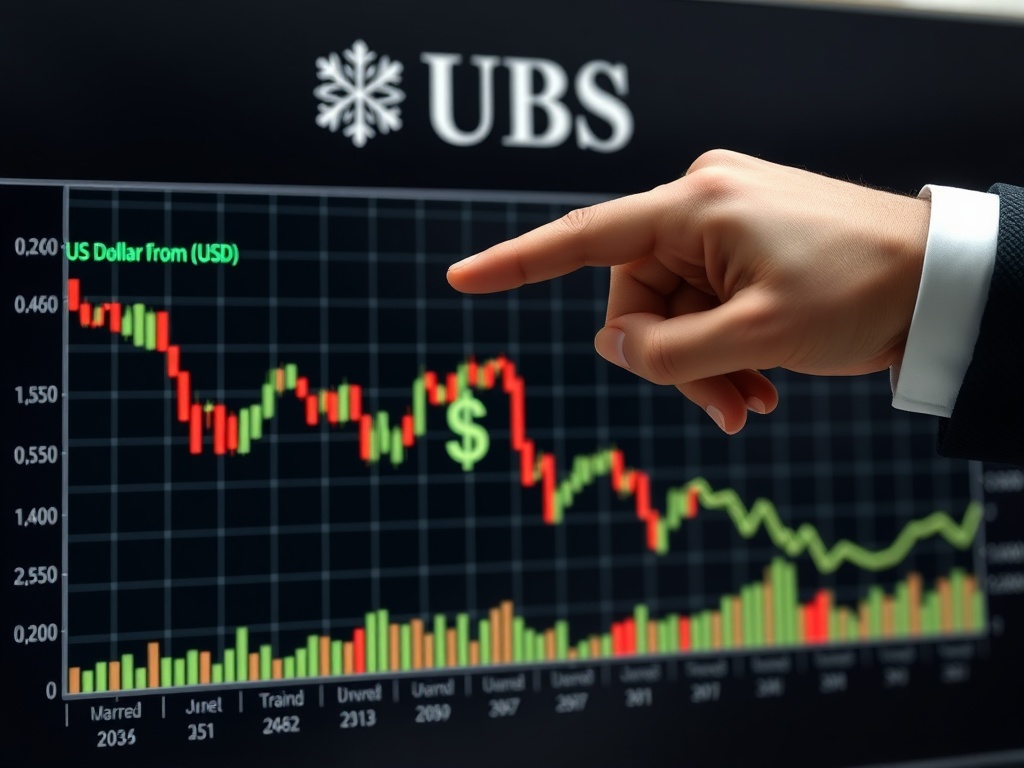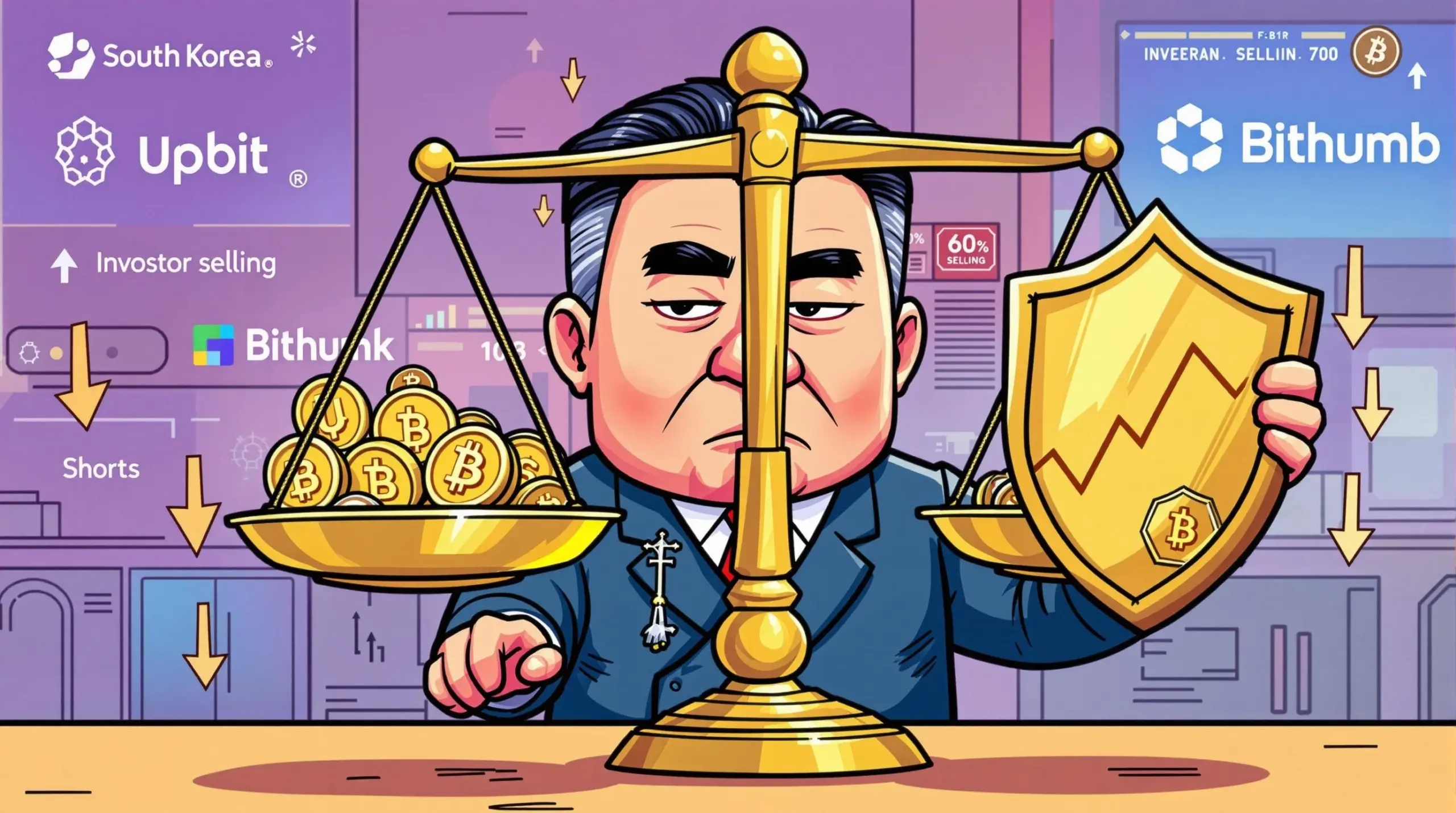BitcoinWorld

USD Upside: UBS Unveils Profitable Selling Strategies for Savvy Investors
In the dynamic world of finance, where every major economic shift can send ripples across global markets, understanding the nuanced perspectives of leading institutions is key. For those of us navigating the exciting, yet volatile, landscape of cryptocurrencies, it’s crucial to remember that macro trends in traditional finance, especially concerning major currencies like the US Dollar (USD), often dictate broader market sentiment and liquidity. Recently, a significant insight from UBS has caught the attention of market watchers: they see compelling opportunities in selling USD upside. But what exactly does this mean for your portfolio, and how can you position yourself to potentially benefit?
Decoding the USD Upside: Why UBS Sees Opportunity in Selling?
When UBS talks about “selling USD upside,” they are not necessarily predicting a catastrophic collapse of the dollar. Instead, they are signaling a belief that the dollar’s recent strength, or its potential for further significant gains, is limited. This perspective suggests that the risk-reward profile for betting on continued dollar appreciation is unfavorable, and that opportunities lie in positioning for either a consolidation, a modest decline, or a slower pace of appreciation against other major currencies. Essentially, it’s about capitalizing on the idea that the dollar’s rally may be running out of steam.
Why this shift in outlook? Several factors contribute to UBS’s strategic view:
- Peak Interest Rates? The US Federal Reserve’s aggressive rate hiking cycle has been a primary driver of dollar strength. However, as inflation shows signs of cooling and the Fed signals a potential pause or even future cuts, the interest rate differential favoring the USD might narrow.
- Global Growth Rebalancing: While the US economy has shown resilience, other major economies, particularly in Europe and Asia, are starting to show signs of recovery or stabilization. This could lead to a rebalancing of global growth expectations, reducing the dollar’s safe-haven appeal.
- Valuation Concerns: After a period of strong performance, the dollar may be considered overvalued against some currencies, making it ripe for a correction or mean reversion.
For investors, this insight is a call to re-evaluate their currency exposures. It’s about recognizing that the easy gains from a relentlessly strong dollar might be behind us, and that a more nuanced approach is now required to find profitable avenues in the currency market.
Forex Market Analysis: Unpacking the Drivers of Dollar Dynamics
UBS’s stance on the dollar is rooted in a comprehensive Forex market analysis that considers a multitude of economic and geopolitical factors. The currency market, the largest and most liquid financial market in the world, is a complex interplay of interest rates, economic growth, inflation, trade balances, and investor sentiment. Understanding these drivers is crucial to interpreting any institutional outlook.
Key elements that UBS likely scrutinizes include:
- Monetary Policy Divergence: The actions of central banks globally are paramount. While the Fed has been hawkish, the European Central Bank (ECB) and the Bank of Japan (BoJ) have adopted different paces. As these policies converge or diverge, they directly impact currency valuations. UBS is likely forecasting a narrowing gap in policy stances, which would reduce the dollar’s relative attractiveness.
- Economic Data: Employment figures, GDP growth, retail sales, and manufacturing data from major economies provide a snapshot of economic health. Stronger data from other regions relative to the US could shift capital flows away from the dollar.
- Geopolitical Stability: In times of global uncertainty, the dollar traditionally acts as a safe haven. If geopolitical tensions ease, or if new areas of stability emerge, the demand for the dollar as a safe asset might diminish.
Consider this simplified comparison of key factors influencing major currency pairs:
| Factor | US Dollar (USD) | Euro (EUR) | Japanese Yen (JPY) |
|---|---|---|---|
| Interest Rate Outlook | Peak/Potential Cuts | Continued Hikes (slower) | Ultra-loose (potential shift) |
| Inflation Trend | Decelerating | Sticky, but decelerating | Rising (from low base) |
| Economic Growth | Resilient, but slowing | Improving, but fragile | Modest recovery |
| Safe Haven Appeal | High (decreasing) | Moderate (increasing) | High (traditional) |
UBS’s analysis likely suggests that the factors that have historically supported dollar strength are either losing momentum or are being counterbalanced by improving conditions elsewhere. This nuanced view is essential for developing effective currency trading strategies.
Currency Trading Strategies: Navigating the Waters of Dollar Weakness
If UBS sees opportunities in selling USD upside, what practical currency trading strategies can investors consider? It’s not about making reckless bets, but about strategic positioning to benefit from anticipated shifts in currency valuations. Here are some approaches to explore:
-
Shorting the Dollar Against Stronger Counterparts: This is the most direct approach. If the dollar is expected to weaken, one would sell USD and buy a currency expected to appreciate. Common candidates include:
- EUR/USD: As the European economy potentially strengthens and the ECB continues its tightening cycle (even if at a slower pace), the euro could gain against the dollar.
- JPY/USD: The Bank of Japan has maintained ultra-loose monetary policy for an extended period. Any shift towards tightening, or even a hint of it, could lead to significant yen appreciation.
- GBP/USD: While the UK economy faces its own challenges, if inflation proves persistent and the Bank of England maintains a hawkish stance longer than the Fed, the pound could find support.
-
Utilizing Options and Derivatives: For more sophisticated investors, options contracts can offer leveraged exposure with defined risk. Buying put options on the USD or selling call options against it can be ways to express a bearish dollar view. Futures contracts also provide a way to gain exposure to currency movements.
-
Hedging Existing USD Exposure: For businesses or investors with significant assets denominated in USD, a strategy to sell USD upside could involve hedging. This protects against potential losses if the dollar weakens, safeguarding the value of their dollar-denominated assets when converted back to their base currency.
-
Diversifying Portfolios Away from USD-Centric Assets: Beyond direct currency trades, investors can indirectly express a view on dollar weakness by increasing allocations to assets that typically perform well when the dollar is declining. This could include:
- Commodities (like gold and oil, often priced in USD).
- Emerging market equities and bonds (which often benefit from a weaker dollar as it eases their dollar-denominated debt burden).
- Non-US developed market equities.
It’s crucial to remember that any trading strategy involves risk. Proper risk management, including setting stop-loss orders and understanding position sizing, is paramount. Always align your strategy with your risk tolerance and investment goals.
The Broader UBS Outlook: A Comprehensive Economic Perspective
The UBS outlook on the dollar is not an isolated prediction; it’s part of a broader, holistic view of the global economy. Their analysis encompasses everything from inflation trajectories and central bank responses to geopolitical developments and shifts in global trade dynamics. This comprehensive approach is what lends weight to their specific currency calls.
What are the underlying pillars of this broader UBS perspective that inform their dollar stance?
-
Inflationary Dynamics: UBS likely anticipates that global inflation, while still elevated, is on a decelerating path. This expectation reduces the urgency for central banks, including the Fed, to maintain ultra-tight monetary policies, thereby diminishing the allure of high-yielding dollar assets.
-
Recessionary Risks: While a hard landing might be avoided, UBS may foresee a period of slower growth or a mild recession in key economies. Such an environment could prompt central banks to ease monetary policy, which typically weighs on a currency’s value.
-
Global Liquidity and Capital Flows: As global growth rebalances, capital flows might diversify away from the US. If other regions offer more attractive investment opportunities or yield prospects, the demand for dollar-denominated assets could wane, contributing to dollar weakness.
-
China’s Reopening and Impact: The reopening of China’s economy has significant implications for global growth and trade. A stronger Chinese economy could boost demand for commodities and other currencies, potentially diverting capital from the dollar.
This multi-faceted analysis forms the bedrock of UBS’s confidence in identifying opportunities to sell USD upside. They are not merely looking at interest rates in isolation but considering the complex web of interconnected global economic forces.
Dollar Weakness: Implications Across Global Markets and Beyond
A period of sustained dollar weakness, as anticipated by UBS’s strategic view, would have profound implications far beyond just currency trading. Its effects would ripple through various asset classes and global economies, indirectly influencing even the cryptocurrency market.
Here are some key implications:
-
Commodity Prices: Commodities like oil, gold, and industrial metals are typically priced in US dollars. A weaker dollar makes these commodities cheaper for holders of other currencies, thereby increasing demand and potentially pushing up their prices. This could be a boon for commodity-exporting nations and related companies.
-
Emerging Markets (EM): Many emerging market countries and corporations have significant dollar-denominated debt. A weaker dollar reduces the cost of servicing this debt, freeing up capital and potentially boosting economic growth in these regions. This often leads to increased investor interest in EM equities and bonds.
-
US Corporate Earnings: For US multinational corporations, a weaker dollar means that their earnings generated overseas, when converted back into dollars, are worth more. This can provide a boost to their profitability and stock performance.
-
Global Trade: A weaker dollar makes US exports more competitive on the global stage, potentially boosting American manufacturing and trade balances. Conversely, imports become more expensive.
-
Indirect Impact on Crypto: While not a direct cause-and-effect, a weaker dollar can indirectly benefit risk assets, including cryptocurrencies. When the dollar is strong, it often acts as a safe haven, drawing capital away from more speculative assets. If the dollar weakens, investors might be more inclined to seek higher returns in riskier ventures, potentially channeling funds into the crypto market. Additionally, a weaker dollar could signal a period of greater global liquidity, which has historically been supportive of crypto valuations.
Understanding these broader implications is vital for investors seeking to diversify their portfolios and capitalize on the shifts predicted by institutions like UBS. It’s about seeing the bigger picture beyond just the immediate currency pair.
Potential Challenges and Risks to the UBS Outlook
While UBS’s analysis of opportunities in selling USD upside is compelling, it’s crucial for savvy investors to acknowledge that no market prediction is without its risks. The financial landscape is constantly evolving, and unforeseen events can quickly alter even the most well-reasoned outlooks. Here are some potential challenges and risks that could impact the anticipated dollar weakness:
-
Unexpected Fed Hawkishness: Should US inflation prove more persistent than anticipated, or if the US economy continues to outperform global peers, the Federal Reserve might be forced to maintain higher interest rates for longer, or even resume rate hikes. This would provide renewed support for the dollar, defying expectations of significant weakness.
-
Global Economic Slowdown: A severe downturn in the global economy, perhaps triggered by a major geopolitical event or a deeper-than-expected recession in China or Europe, could trigger a flight to safety. In such scenarios, the US dollar traditionally acts as the ultimate safe-haven currency, leading to renewed strength despite other factors.
-
Geopolitical Black Swans: Unforeseen geopolitical conflicts, major political instability, or significant global crises could dramatically increase demand for the dollar as a safe asset, irrespective of economic fundamentals. Investors tend to flock to the perceived safety and liquidity of US treasuries and the dollar during times of extreme uncertainty.
-
Divergent Central Bank Policies: While UBS might anticipate a convergence of central bank policies, a renewed divergence, where other central banks (like the ECB or BoJ) become unexpectedly more dovish or the Fed remains significantly more hawkish, could alter currency dynamics.
-
Data Surprises: Key economic data releases, such as surprisingly strong US jobs reports, higher-than-expected inflation figures, or robust retail sales, could challenge the narrative of impending dollar weakness and lead to a rebound.
Investors should continuously monitor these factors and be prepared to adjust their strategies. A flexible approach, rather than rigid adherence to a single forecast, is key to navigating the volatile currency markets.
Actionable Insights for Savvy Investors
Given UBS’s strategic insights into selling USD upside, how can individual investors and those interested in the broader financial ecosystem take actionable steps? It’s about informed decision-making and strategic positioning:
-
Stay Informed on Macro Trends: Regularly follow economic news, central bank statements, and global geopolitical developments. Understand how these factors influence currency valuations and broader market sentiment. Pay particular attention to inflation data and interest rate expectations.
-
Evaluate Your Currency Exposure: Assess your existing portfolio for direct or indirect dollar exposure. Do you hold a lot of USD-denominated assets? Are your international investments hedged against currency fluctuations? Understanding your current positioning is the first step.
-
Consider Diversification: If your portfolio is heavily concentrated in dollar-denominated assets, explore opportunities to diversify into other major currencies or asset classes that tend to perform well during periods of dollar weakness, such as commodities or certain emerging market assets.
-
Explore Specific FX Strategies: For those comfortable with currency trading, research and consider strategies like shorting the dollar against potentially stronger currencies (e.g., EUR, JPY) or utilizing currency-related ETFs or options for managed exposure.
-
Consult Financial Professionals: If you’re unsure about how to implement these strategies or assess your risk, consider consulting a financial advisor. They can provide personalized guidance based on your financial goals and risk tolerance.
-
Monitor Institutional Outlooks: Keep an eye on reports and analyses from leading financial institutions like UBS. While not infallible, their research can offer valuable insights and help you anticipate market shifts.
The opportunity to capitalize on shifts in currency dynamics is not just for institutional traders. With careful research and a strategic mindset, individual investors can also position themselves to potentially benefit from anticipated dollar weakness.
Conclusion: Seizing the Strategic Opportunity in a Shifting Dollar Landscape
UBS’s insightful perspective on selling USD upside offers a compelling narrative for investors navigating today’s complex financial markets. It signals a potential pivot point for the US Dollar, moving from a period of dominant strength to one where opportunities lie in positioning for consolidation or even decline. This outlook is rooted in a comprehensive Forex market analysis, considering factors like peak interest rates, global growth rebalancing, and valuation concerns. By understanding these dynamics and exploring strategic currency trading strategies, investors can prepare for potential shifts. The broader UBS outlook suggests that the forces that have propelled the dollar are losing momentum, leading to implications such as higher commodity prices, stronger emerging markets, and potentially a more favorable environment for risk assets, including an indirect boost for crypto. While risks always exist, recognizing the potential for dollar weakness allows for proactive portfolio adjustments. For savvy investors, this isn’t a call for panic, but rather an invitation to strategically re-evaluate and optimize their exposure in a constantly evolving global economy.
To learn more about the latest Forex market trends, explore our article on key developments shaping the US Dollar and its impact on global liquidity.
This post USD Upside: UBS Unveils Profitable Selling Strategies for Savvy Investors first appeared on BitcoinWorld and is written by Editorial Team





